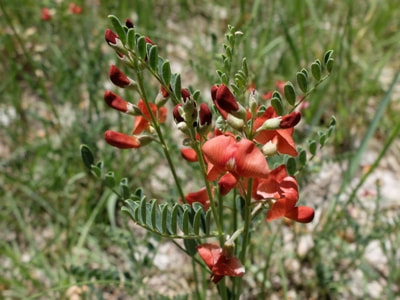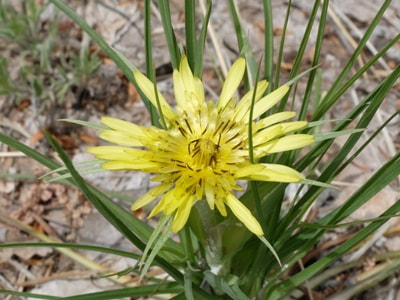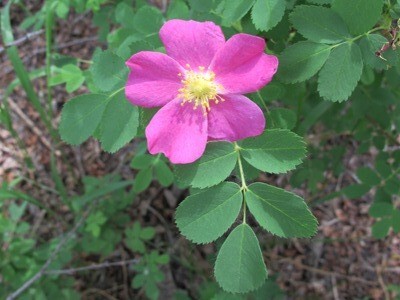|
Found in disturbed moist areas, roadsides, ditches, alkaline soil
Seen blooming in June in Abiquiu This is a long-lived perennial growing up to four feet tall with short white hairs on the stem and many oval leaflets. Its brick-red flowers fade to a light brown-purple when they dry. Seed pods are bladder-like and translucent, and become papery when dry. It is native to Asia but it is known in many other parts of the world as an introduced species and often a noxious weed. It grows in cultivated land and disturbed habitat, easily tolerating alkaline soil. It is commonly seen in areas where alfalfa is grown, because the seeds of the two species look similar and the weed seed is easily imported with the crop seed. It also reproduces by sprouting vigorously from its creeping root system. Alkaloids in the plant may make it poisonous to livestock. In Asia it is used as a folk medicine for treatment of hypertension. I have added a couple of new features to the website. A while ago my niece and I published a book called "My Wildflower Friends". I decided to put it out there so that it can be shared with a kid, or anyone who is a kid at heart. Tap on 4Kids to see it. A lady called Wanda asked me if I would publish the Abiquiú Bloom Blog as a booklet. I decided that with over 100 blooms in the blog there is too much for a booklet, so I have made it easy to print the "Blooming by Month" pages using your browser's print function to make your own booklet. You can decide the way it prints. I found that a scale of 70% and "Portrait" prints a month neatly on two pages. You can print bigger images if you print at 100% in Landscape mode. I hope you find it useful. If you are trying to identify a different flower then you can check what other flowers bloom this month. If you cannot identify a flower from the website send a photo and where you took it to [email protected]. Read online for tips.
0 Comments
Found in sagebrush scrub and forest openings
Seen blooming in June near FS Road 137 in Carson National Forest Last Saturday I took an excellent hike with Kirt Kempter to the rim of Copper Canyon as a reward for donating to the AAESP firetruck fund and learned a lot about the geology of this awesome place we call home. Go online to sign up for future events and to donate. Many different flowers bloom at over 8,000 feet in elevation and Lupine is one of the showiest. They are characterized by their tall spikes of pea-shaped flowers which are usually blue/purple but can be white or pink. Their leaves are divided, spreading like the fingers of a hand, and this species has fine hairs on its stems and the underside of the leaves. They grow from 1 to 3 feet tall in masses, the height and density of the foliage varies by site and moisture. The Navajo applied a poultice of crushed leaves to poison ivy blisters. Some lupines are edible and the beans are a traditional food in some cultures but many contain poisonous alkaloids and should be avoided. Their pods look like hairy pea pods and could be eaten by children. The FDA warns against lupin flour and lupin protein used in gluten-free products if people are allergic to peanuts. Source. If you are trying to identify a different flower then you can check what other flowers bloom this month. If you cannot identify a flower from the website send a photo and where you took it to [email protected]. Read online for tips. Found in meadows and disturbed soil
Seen blooming in June by Hwy 84 in Abiquiu From a distance Yellow Salsify looks like a very tall, large-headed, dandelion. It grows to 3 feet tall with grass-like leaves and a hollow stem which oozes a milky sap when broken. The showy flower head can be over 2 inches across with long, narrow bracts extending beyond the petals. Flowers open early in the day and close by early afternoon and may not open at all during cloudy or rainy days. It produces a seed head like a dandelion that can be 4 inches across. For centuries it has been used as both an edible and medicinal plant. It has been used for sore throats, tonsillitis, whooping cough, nosebleeds, urinary tract infections and lung issues. Also, it is said to lower blood pressure, stimulate hair growth, increase circulation, improve bone density, improve digestion and boost immunity. All parts of the plant are edible and are best eaten when young. The flowers and leaves can be added to soups or salads and the stems eaten like asparagus. The root can be eaten raw or cooked but should be cleaned well and the skin scraped off. Natives Americans chewed the coagulated milky sap like gum. Source. If you are trying to identify a different flower then you can check what other flowers bloom this month. If you cannot identify a flower from the website send a photo and where you took it to [email protected]. Read online for tips. Found on dry slopes, along roadsides
Seen blooming in June near MM 209 by Hwy 84 in Abiquiu Wild Rose grows in thickets to several feet high with numerous prickly stems. The showy flowers can range from pale pink to deep rose and have a delightful, delicate scent. The fruits of the Wild Rose are known as rose hips and are edible after several frosts. The hips are a good source of vitamin C and are consumed by birds, bears, and other animals, as well as humans. Wild Rose has been heavily used for food and a variety of other purposes by Native Americans The hips can be made into jam, jelly, syrup and tea. The roots make an orange dye. A poultice of various plant parts may be used for burns, boils, sores, cuts, bee-stings and wounds. A decoction of the roots was used to treat diarrhea. Branches were used to sweep out the grave before the corpse was lowered into it to prevent someone else's spirit from being buried with the dead person. Branches were also boiled in water and used to soak fishing lines and nets to obtain good luck. There is much more. Source. If you are trying to identify a different flower then you can check what other flowers bloom this month. If you cannot identify a flower from the website send a photo and where you took it to [email protected]. Read online for tips. |
AuthorI am Marilyn Phillips, a native of England, whose love of nature and the outdoors from childhood brought me by a circuitous route to Crested Butte, Colorado in 1993 and 16 years later to northern New Mexico. My exploration of the many trails in these areas, my interest in wildflowers and photography, and career in computer system design came together in this creation. If you have any corrections, comments or questions, please contact me by email. Archives
September 2025
Categoriescopyright © 2020
|






 RSS Feed
RSS Feed